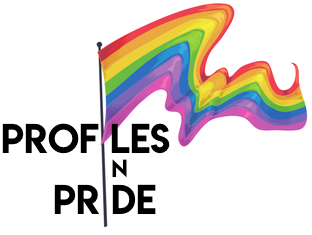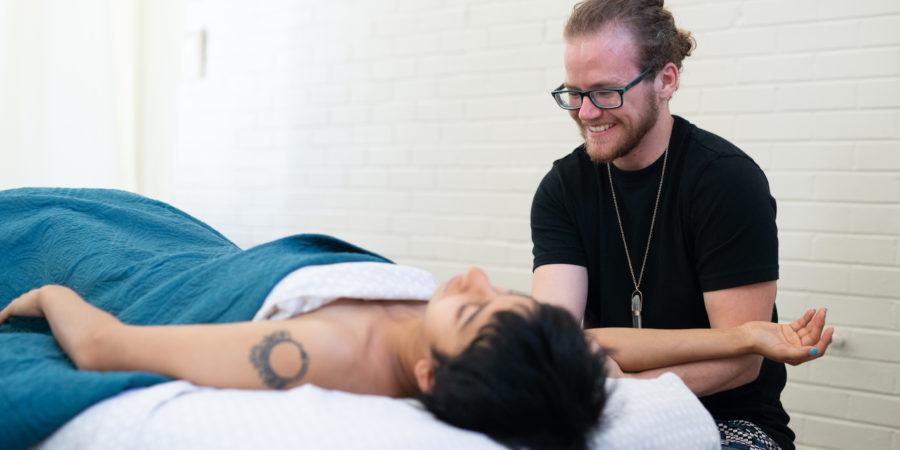Kelly Marshall, who was assigned female at birth, began practicing yoga as a kid with their mom at the YMCA. Over time, they became increasingly passionate about yoga and wellness, and as an adult, they pursued a career in massage therapy. After many years of this work, they decided to get certified as a yoga therapist. Unlike their peers in yoga training, they didn’t initially want to lead classes; instead, they wanted to be able to incorporate the benefits of yoga, meditation, and mindfulness into their one-on-one work with LGBTQ+ clients, many of whom needed more stress relief than just a massage could provide.
In Marshall’s teens and twenties, they identified as a genderqueer lesbian. Then one day in an intensive yoga teacher training, one of Marshall’s poses seemed wrong, but they couldn’t find a single issue with their posture or alignment. In an emotional epiphany, they realized it wasn’t the pose that was out of alignment, but their experience of seeing their body in it. They felt overcome by gender dysphoria for the first time and realized they were transgender.
Marshall began transitioning from female to male, believing that their only option was to transition into a binary, stereotypical image of a male. They began dressing, appearing, and acting very traditionally masculine. But with time, they realized this just wasn’t authentic and that their gender journey didn’t have to be so black and white. Marshall, 34, now identifies as a nonbinary, transmasculine person.
In 2016, Marshall opened their current business in Austin, Spectrum Yoga Therapy, to offer a safe, healing space for queer people, especially those who feel uncomfortable in traditional wellness spaces. They offer a combination of one-on-one yoga therapy, massage, mindfulness coaching, and Reiki to help relieve stress and encourage wellbeing.
Marshall says accessibility and inclusivity is often an issue in wellness spaces and yoga studios. They feel passionate about giving any and every LGBTQIA person a place where they can feel safe being touched and connecting with their bodies, and where they can learn practices to help them manage stress, practice self-compassion, and build emotional resiliency — something that’s especially important for those in oppressed minorities, Marshall says.
This is Marshall’s story of coming to terms with their identity, using yoga and meditation to navigate their journey, and creating a wellness business to help the LGBTQ+ community heal and thrive.
Profiles in Pride: When did you realize you were trans and nonbinary, and what did the coming out process look like for you?
Kelly Marshall: My coming to terms with my identity has been and continues to be an evolution of coming into greater clarity about the way that I move in the world, authentically and naturally. I’m continually letting go of my fears and stories about people not “getting it” and rejecting me or hurting me because I don’t adhere to what they expect, either interpersonally or societally.
First of all, coming out and identifying as trans: I always identified as genderfluid or genderqueer, even when I identified as a lesbian. That happened in high school in terms of my sexual awakening. Then in 2012 or 2013, I was in my 200-hour yoga teacher training, doing yoga eight hours a day, every day, in front of a mirror. It was very intensive. Some of it was sitting down and talking, but most of the time I was very embodied. I had never spent that much time in front of a mirror in my body.
I was looking in the mirror while doing Warrior 2. I was looking at the pose and I thought, “This pose doesn’t look right, but I don’t know why.” I triple-checked my alignment and all the things I was taught. I was like, “No, the pose is fine; it’s the body doing the pose.” I had this “oh shit” moment as I was looking at myself in the mirror. I realized I didn’t feel in alignment with my body at all. That was the beginning of my experience of dysphoria.
I was really curious about that experience right off the bat. My journey into transitioning really began with yoga, and being inquisitive and very mindful about what that looked like.
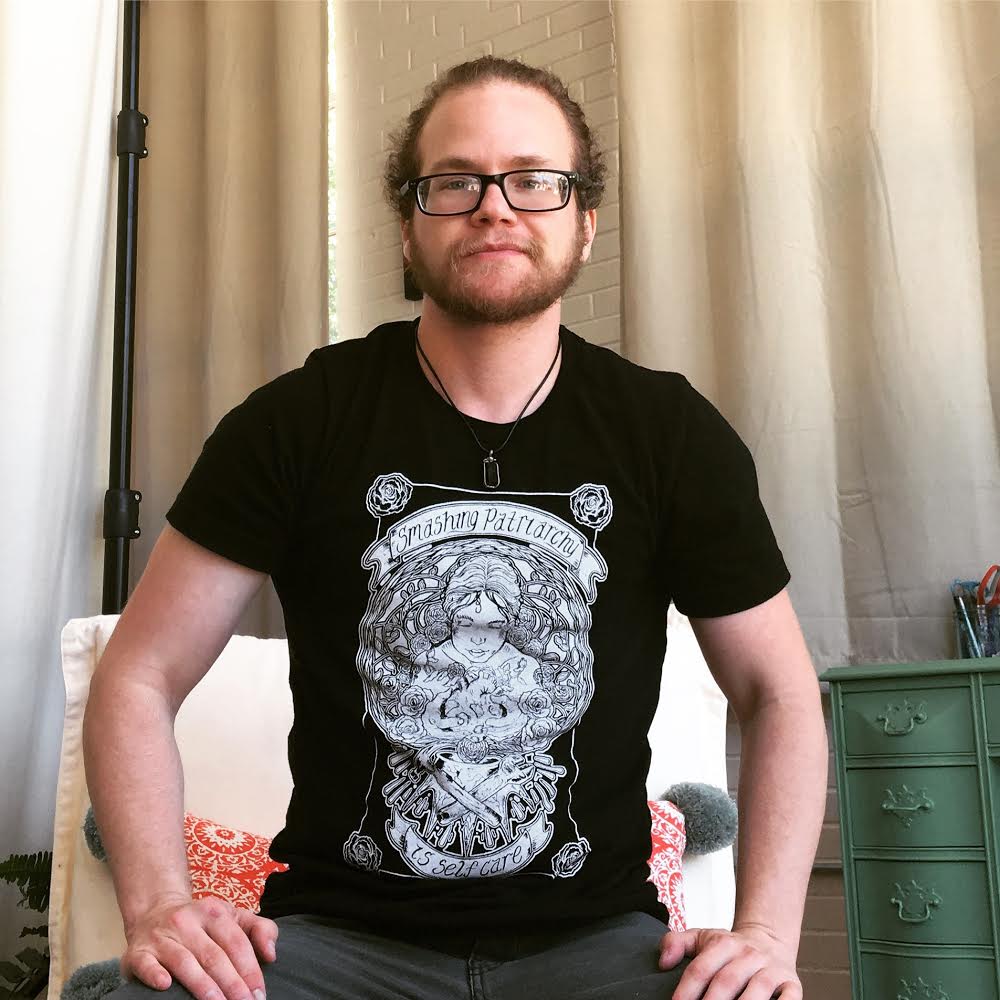
Then a few years into my transition, really in the last couple of years, I realized that my feelings of gender fluidity and being genderqueer never really went anywhere — I just did a lot of things at the front end of my transition to feel like I was very masculine. I adhered to whatever I thought society was telling me what a man was. I felt really obligated, like “I have to do the man things because I’m a man now.” My experience of transition was very binary, like I’m going from one gender and I’m now the other gender and here’s what I have to do. It was painful; I had a lot of grief around this story of leaving one gender and becoming another.
Then I realized that doing those things or even identifying as a man is not even close to who I am or authentic in how I move through the world. I was like, “Why am I doing this to myself?” So I stopped that and I just allowed myself to go back to who I felt I always was: a genderfluid, genderqueer, non-binary human, but embodying that in a masculine-presenting body rather than a feminine-presenting one.
If you’d seen me eight years ago, I identified as a femme lesbian, because it was the easiest way to describe what I was doing with femininity. I wore it as drag; it almost felt performative. To know that aspect of my past and to see me as transmasculine now, you’d be like, “What?! Who are you?”
So I started wearing makeup and finding clothing that was nonbinary and playing with that. I was really inspired by Jeffrey Marsh, who also identifies as “they,” is spiritual person, and is a Buddhist practitioner and speaker. It’s really interesting to identify as transmasculine and also to be openly nonbinary.
It confuses people, because a lot of people think that the transgender journey is very binary, like you move from one into the other. There’s also the theme of if you’re going to be seen as a valid trans person, you really have to adhere to cisgender binary ways of being or you have to pass as cis and try to do your best to fit in. It’s almost echoing those old narratives that we have as queer people, like “you can be gay, just don’t throw it in our faces” kind of thing.
PIP: That makes a lot of sense! To back up, how did you first get into yoga and meditation?
KM: I’ve always practiced yoga; I started practicing when I was 12 at the Y with my mom. Later on I started really digging deep into my practice and I committed to a 200-hour training in order to become a yoga therapist. I was the only one in my class that was wanting to do that. Everyone in my class wanted to teach vinyasa flow, but I really wanted to work individually with people.
I’d been a massage therapist previous to that for a really long time, and I was ready to meet my clients in a different space and help them have longevity with making lifestyle changes, with being more mindful and with exploring other ways of approaching things, rather than the band-aid of only massaging people because they’re stressed.
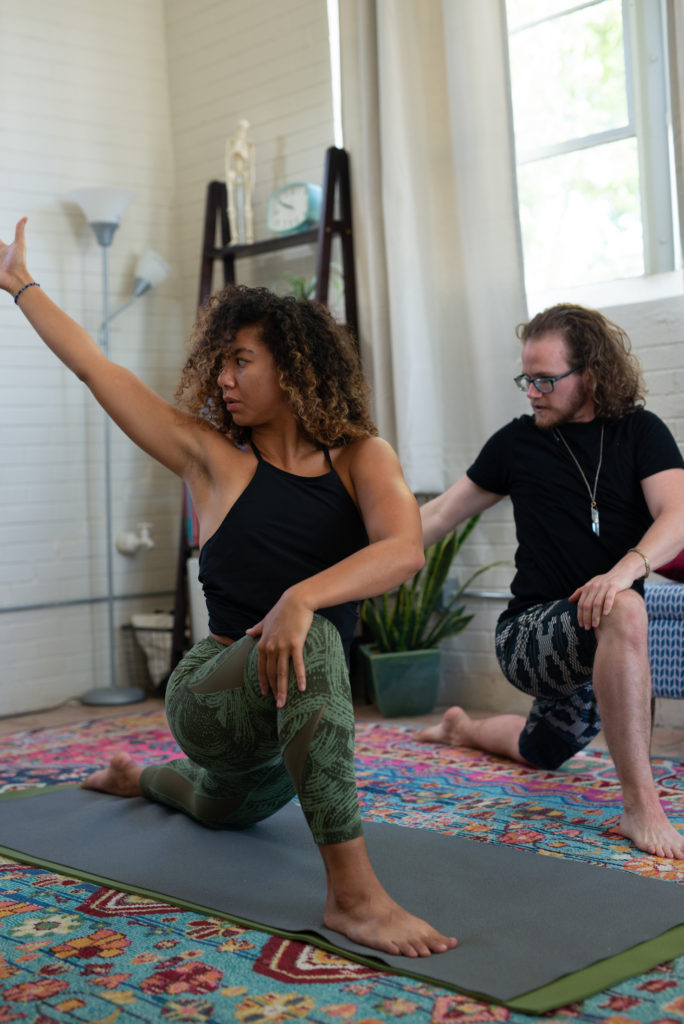
PIP: How has yoga, meditation, and mindfulness helped you throughout your journey?
KM: It really helped me deal with dysphoria in a lot of ways. At the beginning of my transition, I waited for a long period of time before I took any steps because I’d lived in the lesbian world for a long time, and I had a little bit of internalized misandry, or a hatred of men. I feel really vulnerable talking about this, but I was afraid of becoming this thing that I didn’t understand or have a point of reference for and didn’t really have positive experiences with, since my previous experiences were as a lesbian who’d endured sexual abuse from dudes.
There were a lot of layers to me coming to terms with my transgender identity and then taking steps toward it, and it was very painful. I had a lot of resistance toward it. I got to a place where I was fighting against myself so much that I was considering suicide. My partner at the time was like, “OK, we’re done with this, let’s not do this anymore, you’ve reached the pinnacle of despair. Let’s get you on antidepressants and started on hormones and just see what happens.”
Once I’d gotten to a place where I could meditate — because I was in such a state of turmoil that I couldn’t sit still at first — that really helped me parse out those hard questions about my identity and all of the stuff that society was throwing at me, that queer culture was throwing at me, that weird TERFy feminism was throwing at me, all of these different pieces.
I was able to just filter through the bullshit and get clarity on who I was in spite of all that and how to be who I was. How to be in my own skin in a way that felt safe, and eventually even comfortable and joyful.
I don’t think dysphoria is any one specific thing; I don’t think it’s rooted in any one specific thing for trans folks. I think it’s a lot of different pieces. It has to do with society’s expectations of us, our own expectations, shame, and a genuine feeling of not feeling safe or congruent in our own bodies for whatever reason. I got to delve into the layers of what all that was for me through meditation and through yoga, and I got to feel a sense of relief and peace and awareness and awakeness, and I’m extremely grateful for that.
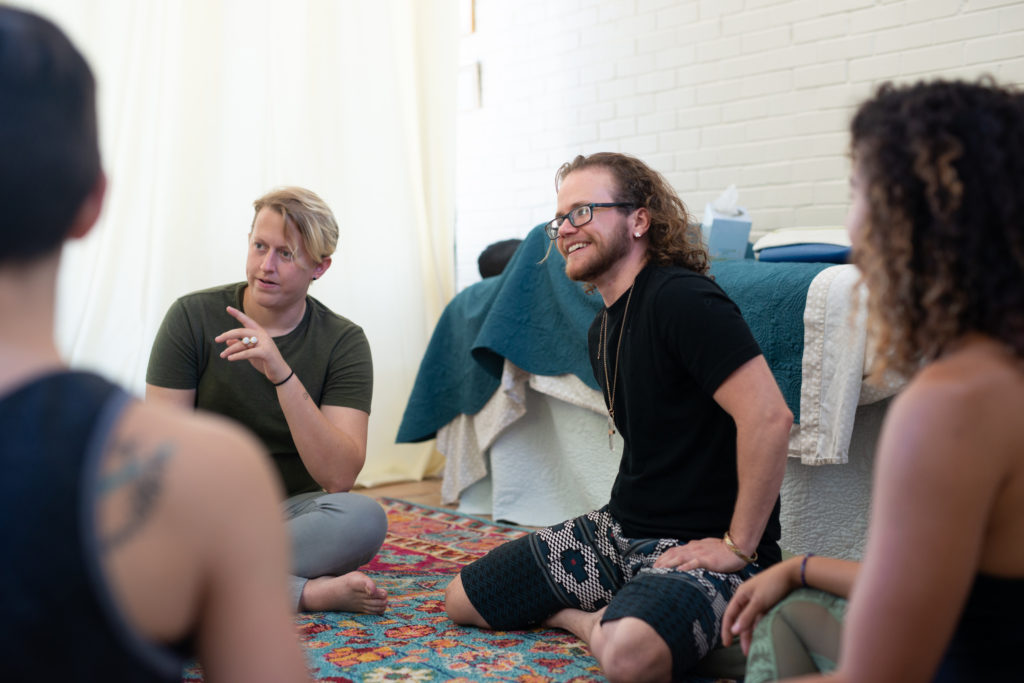
PIP: That’s incredible. When and why did you start your business, Spectrum Yoga Therapy?
KM: I started it July 2016. It was really about accessibility, because I found when I started moving into yoga world, it’s pretty straight and binary and white. When you get into the practices of yoga more deeply, it can be confrontational for everyone, but especially for people who are in our community, because you’re opening a container for people to connect with their bodies and their deeper selves. I wanted a safe space for that and I found there weren’t any spaces for that.
Before I opened my business, I started connecting with every queer and trans yoga and wellness practitioner I could find and built a little community (Austin Queer Yoga Collective), because I needed to figure out what us queers needed from these practices — and each other — and how we could make those things accessible to everyone, even those who’d never practiced yoga or meditated a day in their lives.
Also, when I was moving through my transition, thankfully I was in the wellness community and I had friends I felt like I could trust in terms of receiving these various forms of healing: acupuncture, energy work, psychotherapy, meditation, the vast buffet of tools, techniques, and philosophies that yoga offers, and of course, massage. That was really crucial for me, to receive safe loving touch, attunement, and attention from other people while I was working through all my stuff. I wanted to provide that space for others, in the same way it was provided for me.
I also realized in terms of the wellness community and the services that are offered across the board, there’s just not a lot of accessibility, awareness, and sensitivity for people who are underprivileged, disabled, people of color, people with bigger bodies, people who are queer, trans, nonbinary — people who generally wouldn’t feel welcome or safe in yoga and wellness spaces. I just wanted to start that conversation, have those conversations, and create a space where people could feel safe and included to heal.
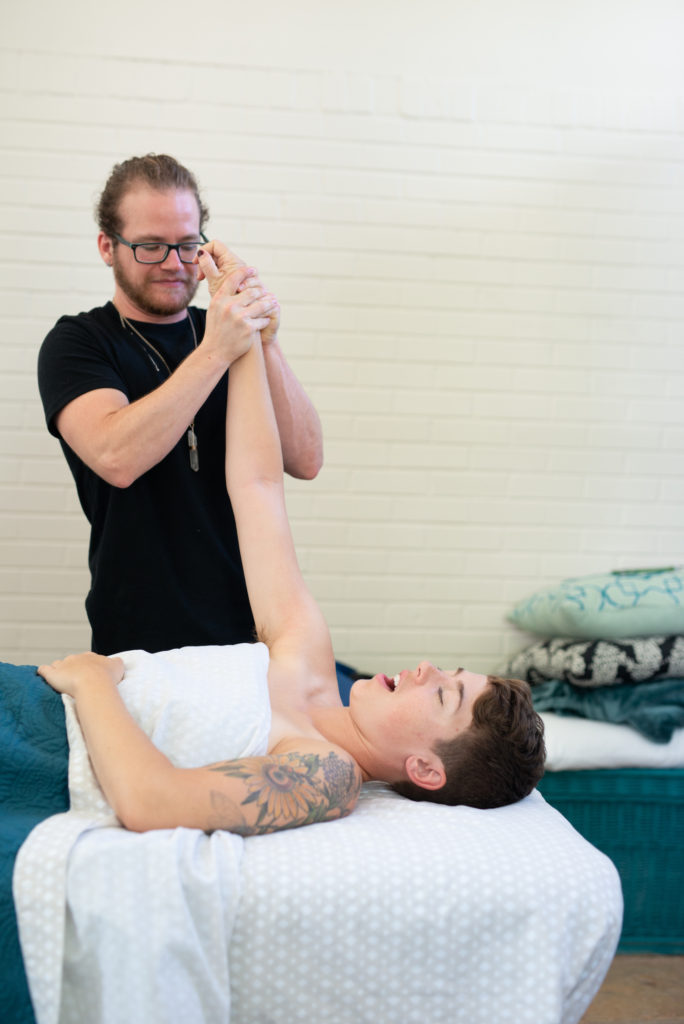
PIP: How do the practices you work with particularly benefit the LGBTQ+ community?
KM: I think the LGBTQ+ community, especially in this current administration, is still dealing with being an oppressed minority. When you have a culture of oppression, there’s this commonality of trauma that we share of always being unsure about the safety of spaces we’re in, even queer spaces!
There’s meta layers to that too, as we’re becoming more aware and having these conversations amongst ourselves about privilege and access and whiteness and all those things. So I think what can happen is instead of getting still, and instead of looking within and doing the hard work of self-reflection, a lot of people will react. A lot of people will also numb out and will try to find ways to avoid the hard business of being in this community and being in the space that we are in now, culturally and politically.
I think these practices offer so much breathing room. An experience of relief, release, allowing, and an invitation to really take a stand for our own self-care and self-love, which I think is just revolutionary and so important. I really believe that queers are going to save the world, just by being our beautiful, authentic selves. Radical self-love, self-compassion, and the practices of self-care are so essential to our wellbeing as a community.
And what better way to change the world than by first protecting and loving the precious and beautiful weird, sensitive rebels that we are? The dominant culture often takes its cues from us queers. What if we lead by example and show them how much love we deserve by showering it on ourselves?
I think we’ve had these old patterns and these old tapes of “let’s just go out and party and we’ll drink and we’ll argue with each other about the best way to make effective change and get mad at ourselves and each other for not measuring up.” And try to find the enemy, try to find someone or something to blame, instead of looking within and trying to be really clear on what we can offer the world in an authentic way that is empowered. At the end of the day, it’s about feeling empowered. That’s what I hope to offer my clients.
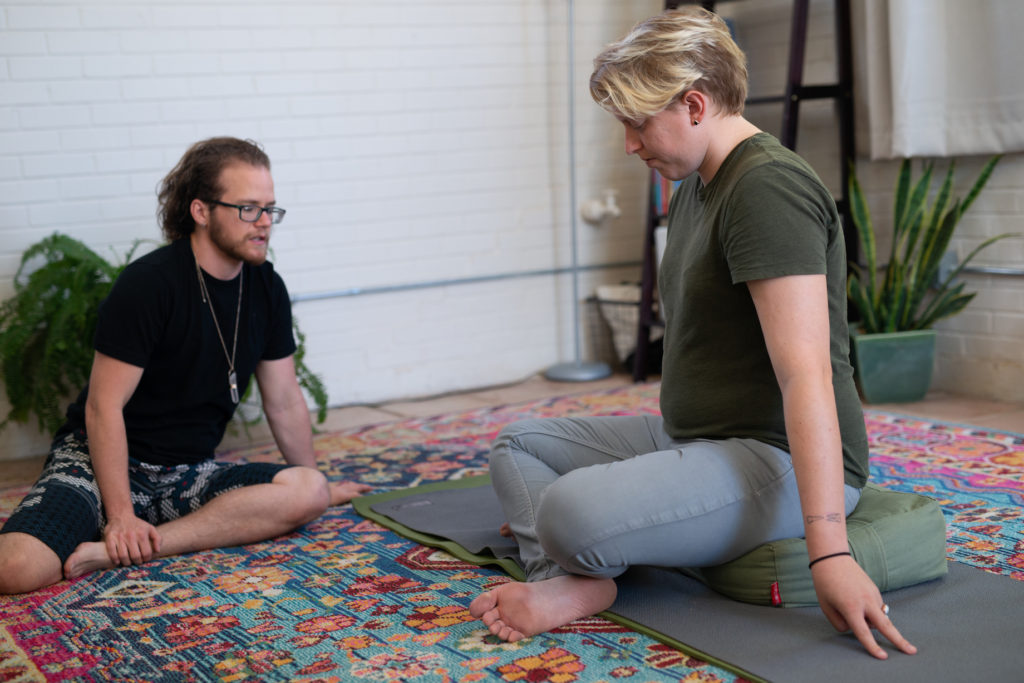
PIP: I love that. Our LGBTQ+ community center in San Antonio, The Pride Center, recently offered some free yoga classes; I thought that was brilliant since transgender or nonbinary people might not feel comfortable in a traditional yoga setting.
KM: Yes, especially ones with mirrors! I didn’t really understand how much of a triggering situation I had put myself in, but that’s what it took for me to come to terms with myself. Weirdly though, yoga was my safe space. I came out literally in that moment; I had to come out to my class because I was bawling!
That happens in those kinds of trainings; everyone loses their shit at some point. It’s not a yoga training until you lose your shit! So it was a safe space, but there’s also so much education that has to happen in those spaces, and that’s something that I’m doing with Yoga Yoga here in Austin, and hopefully something that will go bigger in talking to wellness communities in general about inclusivity.
While there’s so much good intent, there’s really a lot of confusion about how to offer these spaces for people that are underprivileged and underrepresented, as well as how to screw up and then how to have those conversations and make things right when you do screw up.
Here in Austin, a woman named Erica Nix opened Transform, the only LGBTQ+ fitness space in Texas. It’s a gym focused on supporting everybody in the community, especially with spaces for trans folks. That’s where I was teaching and continue to teach queer yoga. She offers these performance art/aerobics classes like Jane Fonda or Richard Simmons — it’s very queer. She wears leotards and she has a crazy head of curly red hair. She’s quite a presence!
On Thursdays, she does a class called Transitions. What’s been really rewarding about living in Austin specifically is there’s a very nurturing trans community, and so we all end up going and working out at her classes on Thursdays. It’s so cool to have a bunch of trans folks across the spectrum, from transfeminine to nonbinary to transmasculine — all of us working out together. It’s just magical.
Keep up with Kelly on Facebook or on Instagram @spectrumyogatherapy.
Photos by Erica Nix
